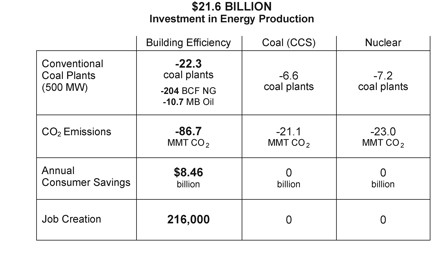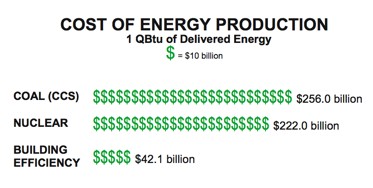A new report from Architecture2030 shows that solving the climate change crisis can save billions of dollars, stimulate a deteriorating U.S. economy, and create high quality jobs (full report here).
Complex problems sometimes require the simplest of solutions. One of the most important questions facing those attempting to solve the climate crisis is, “How do we reduce CO2 emissions dramatically and immediately?” The simplest answer is, “Turn off the coal plants.“
Although coal produces about half of the energy supplied by the electric power sector, it is responsible for 81% of the sector’s CO2 emissions. According to recent paper by Dr. James Hansen et al., titled "Target CO2: Where Should Humanity Aim?" (PDF), if we are to have any chance of averting a climatic catastrophe, we must implement an immediate moratorium on the construction of any new conventional coal-fired power plants and complete a phasing out of all existing conventional coal plants by the year 2030. Anything short of this will fail (call Congress on Earth Day, April 22nd, supporting the Markey Waxman bill and a moratorium on coal).
To turn off the coal plants, one must replace them with another energy source and/or eliminate the demand for the energy produced by these plants. And the economic feasibility of any proposed actions regarding climate change is a particularly important consideration in this time of looming recession.
Today, of the approximately 38.5 QBtu of primary energy consumed by residential and commercial building operations in the U.S. each year, 27.3 QBtu is consumed in the form of electricity. About 14.2 QBtu of this electricity is produced by conventional coal-fired power plants. According to a recent McKinsey Global Institute report, the implementation of straightforward, off-the-shelf residential and commercial building efficiency measures would reduce energy consumption by 11.1 QBtu for an investment of $21.6 billion per QBtu.
Investment in building energy efficiency is surprisingly effective. A single investment of $21.6 billion would replace 22.3 conventional 500 MW coal-fired power plants, reduce annual CO2 emissions by 86.7 million metric tons, save 204 billion cu. ft. of natural gas and 10.7 million barrels of oil each year, save consumers $8.46 billion in energy bills annually (less than a 3-year simple payback), and create 216,000 permanent new jobs.
By comparison, as the chart below illustrates, neither "clean" coal plants nor nuclear plants can compete with building energy efficiency. Investing the same $21.6 billion in either "clean" coal plants or nuclear plants costs significantly more (rather than saving consumers money), replaces far fewer conventional coal plants, reduces CO2 by far less, and would create no new jobs, since the jobs created by these new plants would simply replace existing conventional coal plant jobs.

In addition, because building is a local activity (construction jobs cannot be outsourced), the money invested in this sector is spread across the entire country and across all industries, from wood, metals, and glass to sealants, paint, and banking. Both the $21.6 billion invested and the $8.46 billion saved on energy bills will cycle through the economy several times.
A comparative analysis of the cost of energy production also provides useful information. As shown in the chart below, the cost to build enough new coal plants with CCS to produce just one QBtu of delivered energy would be $256 billion. The cost to build enough nuclear plants to produce just one QBtu of delivered energy is $222 billion. The cost to incorporate energy efficiency measures into residential and commercial buildings to negate the need for one QBtu of delivered energy is $42.1 billion.

While coal with CCS is at least 20 years out and a single nuclear plant takes 8 to 12 years to get on line, energy efficiency measures can be implemented today — at today’s prices, with off-the-shelf materials, appliances, and equipment.
The clear winner among the energy solutions being considered today is building energy efficiency. To make the building energy efficiency solution a reality, we recommend the implementation of the following plan of action, which we call the 2030 Blueprint:
- Implement an immediate moratorium on the construction of any new conventional coal plants, and the gradual phasing out of all existing conventional coal plants by 2030 in order to:
- place an immediate cap on coal plant emissions while allowing time to retrain coal workers for new jobs.
- Require that all developments using federal funds meet the 2030 Challenge targets in order to:
- create additional models of building energy efficiency for the marketplace.
- Upgrade the National Energy Conservation Code Standard to the 2030 Challenge targets for residential and commercial buildings in order to:
- immediately stabilize and begin reducing energy demand in the building sector.
- Invest $21.6 billion each year for five years in building energy efficiency measures, through existing federal programs (i.e., New Markets Tax Credits; Low Income Housing Tax Credits; a five-year extension and increased funding for efficiency in the Energy Policy Act) and new energy efficiency incentives, tax credits, and programs in order to:
- stimulate building construction
- reduce annual building sector energy consumption by 5 QBtu
- reduce annual U.S. CO2 emissions by 433.5 MMT
- save consumers $128 billion (which more than covers the cost of this solution)
- create more than one million permanent new jobs
- Fund and implement a joint labor-management job-training program for displaced coal industry jobs, based on successful models developed over the past two decades, i.e., in the tire/rubber, steel, automobile, and communications industries.


